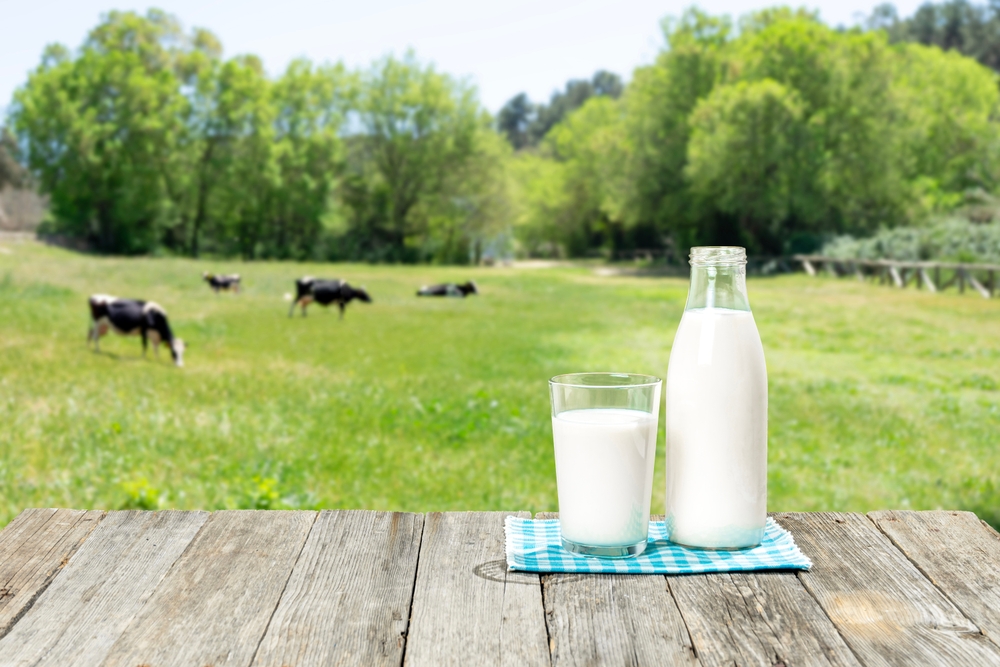Consumers are faced with numerous options when it comes to purchasing cow’s milk, even when non-dairy products are removed from the equation. As you look at row after row of dairy at the store, you may find yourself wondering: How did we end up with so many varieties of cow’s milk? And which one is the healthiest?
History of Milk Production
For over 10,000 years, humans around the world have domesticated milk-producing mammals for milk consumption. Even as early as the Neolithic Era, when human populations transitioned from hunting and gathering to using more advanced tools to cultivate fertile lands and raise animals for food sources, there is evidence of milk products in the human diet. Milk residue found on Neolithic pots throughout Europe suggests many early farmers either drank milk or used it to make cheese and yogurt.
In the early 1600s, Europeans immigrating to the United States brought cattle as a source of meat and dairy products, but milk production and usage was personal, with farmers mostly producing for their families. It wasn’t until the turn of the 19th century that the need for milk became more widespread. As people began to move from rural areas to cities, the demand for milk, cheese, and butter substantially increased, and dairy production and distribution practices developed accordingly to meet the growing needs in urban areas.
The development of a foot-powered milking machine by the Mehring Company in 1892 changed the landscape of dairy farming in that two cows could be milked at once. This quicker collection process was easier on the cows, and the milk was cleaner due to the enclosed suction apparatus and raised bucket off the ground. Around this time, another advancement occurred in the milk industry: The use of heat to remove microbes from contaminated milk, known as pasteurization, was refined, making milk more appealing to those worried about typhoid and tuberculosis — diseases that were commonly spread through unsanitary milk production at the time.
Prior to World War II, pasteurized whole milk (milk without any natural fats removed) was essentially the only option for consumers. Skim milk (milk with most of the natural fat removed and now more commonly called fat-free or non-fat milk) was often considered a byproduct of the butter-making process and was typically thrown out.
During World War II, the United States government put skim milk to use, commissioning dried skim milk powder for soldiers fighting overseas. Facing a surplus of skim milk after the war, the dairy industry searched for a way to market the product. What was once a worthless byproduct suddenly became a “healthy” drink that could help people lose weight. By the 1950s, skim was the milk of choice for diet-conscious consumers. The idea that skim milk was the healthiest choice was also supported by an American physiologist named Ancel Keys. His “Seven Countries Study” in 1958 promoted the belief that saturated fats found in natural butter, eggs, whole milk, cheese, and red meat were linked to cardiovascular disease and as such, food products like whole milk should be avoided. So pervasive was the notion that saturated fats were unhealthy, the food industry changed course by removing natural saturated fats from food products and substituting with unhealthy synthetically produced unsaturated fats from vegetable oils. For much of the 1980s until the early 2000s, consumers were encouraged to avoid fat, which made skim and 2% milk the appealing choices.
We now know that fat isn’t always the enemy and that all fat is not created equal. “Good fats” are found in naturally derived foods like avocados and wild salmon; “bad fats” are found in artificial, processed foods like fried foods and desserts.
Which Milk Is Healthiest?
Milk is naturally high in sugar. The type of sugar it contains is lactose and is difficult for many people to digest, with one study estimating that roughly 70% of adults globally lack sufficient amounts of the digestive enzyme lactase needed to efficiently digest lactose. Milk is also a common food allergen. For these reasons, many choose to avoid milk and other dairy products that contain milk.
Raw Whole Milk
For those wanting cow’s milk in its most natural “whole food” state with its full natural-fat content and without homogenization (the cream layer is left on top) or pasteurization, raw whole milk is the gold standard. If you have access to raw milk from a trusted source, this is your least processed option.
Pasteurized Milk
Homogenized Versus Non-Homogenized Milk
Another important advancement in the milk industry occurred in France in the late 1800s, with the homogenization of milk. In its natural state, milk fat rises and settles on the top to create a rich, creamy top layer. This is what’s known as non-homogenized milk — the milk product has not been altered and the fat globules stick together.
However, in order to get a smooth, uniform texture where the fat is evenly distributed throughout, the milk needs to be homogenized, with the fat globules broken down and dispersed. In 1899, August Gaulin patented a machine that could homogenize milk, thus changing the landscape again for milk production. Not only did homogenization prevent the milk fat from separating, it also extended the shelf life of milk which became vital during the Great Depression and other periods of economic insecurity. Nowadays, homogenized milk is the industry standard with its even consistency and bright white color.
Whole Milk (Full-Fat Milk)
While raw whole milk might not be accessible or desirable for all, there are milk options that retain more of their natural nutritional content including milk fat, which carries the fat-soluble vitamins A, D, E, and K. Whole milk has a fat content of 3.25% milk fat. Whole milk has a higher fat content compared to low-fat or skim milk and is higher in calories but also higher in healthy omega-3 fatty acids, which are beneficial for cardiovascular function, cognitive function, and help lower levels of inflammation in the body. Keep in mind that milk purchased in most grocery stores (even organic milk) is homogenized and/or pasteurized at low, high, or ultra-high temperatures, which does change the healthy natural state of milk.
Reduced-Fat Milk (Low-Fat)
Reduced-fat milk is defined as 1–2% milk fat and has slightly less calories than whole milk.
Skim Milk (Fat-Free or Non-Fat Milk)
Skim milk has a fat content of less than 0.5% and has undergone a process to remove most of the milk fat. Skim milk has fewer calories and a thinner consistency than whole milk and may contain additives like thickeners and sweeteners to improve its taste after the fat has been removed. Compared to full-fat milk, processed skim milk contains less vitamin K2, a crucial vitamin that contributes to skin, bone, and cardiovascular health.
Wiseman Health Take-Home Points
- When choosing any food, the goal is to avoid its most processed version. This also applies to milk. When you can, opt for milk that is in its least processed state. The gold standard is raw milk: It is whole, unpasteurized, and non-homogenized. If raw milk is not a preference or option, then low-temperature pasteurized, non-homogenized options that aren’t 100% raw are recommended — low-temperature pasteurized milk from grass-fed cows is now more widely available in conventional grocery stores than it once was. While the homogenization process doesn’t inherently decrease the nutritive value of milk, it is a form of processing and it is best practice to drink non-homogenized milk with the cream layer on top. To learn more about raw milk and to locate sources close to you, read our article What Is Raw Milk? | Wiseman Health and visit realmilk.com.
- When shopping for pasteurized milk options, try to avoid ultra-high temperature pasteurized heated milk, when possible, as its higher temperature damages more of the nutrients in milk. This type of milk will be labeled ultra-high temperature and ultra-pasteurized, or it will use the acronyms UHT or UP. Many people also take issue with the taste of this kind of milk as it tastes sweeter and has a “cooked” taste. Instead, look for the label pasteurized or low-temperature pasteurized milk instead. Unfortunately, a lot of organic milk is ultra-high temperature pasteurized. Look for organic alternatives that are specifically labeled pasteurized or low-temperature pasteurized when possible.
- The term USDA Organic is the gold standard for organic milk and means that there were no hormones or antibiotics added in the process and no pesticides, fertilizers, or GMOs used in the feed. Other healthy, trusted terms on milk labels include grass-fed, no added hormones, antibiotic-free, and rBST-free or rBGH-free, which are specific terms signifying no bovine growth hormone. The “made with organic ingredients” label indicates at least 70% organic ingredients; however, these products lack the USDA Organic seal that indicates at least 95% organic ingredients.
- We now know that natural saturated fats found in unprocessed whole foods such as beef, eggs, and whole milk are good for our health as long as consumed in moderation. For this reason, if trying to decide between whole milk and low-fat or whole milk and skim, whole milk is the better choice because it retains more of its natural nutrients and is less processed.
- Remember that nature designed milk for babies. Many in the natural health world believe that milk shouldn’t be consumed by older children and adults. If consumed, the best practice is to consume it in its least processed state which is non-pasteurized, non-homogenized and in its whole (full fat) form. Keep this goal of “less processed” in mind when buying milk or any dairy products.
- If you are trying to avoid cow dairy altogether, there are many forms of non-cow dairy milk, or dairy alternatives, such as almond, soy, rice, coconut, and oat milk. When shopping for these plant-based milks, make sure to consume versions that are the least processed with no added sugars.
- Watch our video on the healthiest dairy products and tips on buying the best pasteurized milk at the grocery store: Raw Milk and Why It’s the Healthier Choice | Wiseman Health.
Editor’s Note: This article was originally published on July 3, 2025
Stock, J. T., & Wells, J. C. K. (2023). Dairying and the evolution and consequences of lactase persistence in humans. Animal frontiers: the review magazine of animal agriculture, 13(3), 7–13. doi:10.1093/af/vfad022
Evershed, Richard P et al. “Dairying, diseases and the evolution of lactase persistence in Europe.” Nature vol. 608,7922 (2022): 336-345. doi:10.1038/s41586-022-05010-7
The American Dairy Industry: Early History. USDA National Agricultural Library. Retrieved April 25, 2025 from https://www.nal.usda.gov/exhibits/speccoll/exhibits/show/the-american-dairy-industry/early-history
Foot-Powered Milking Machine Smithsonian. Retrieved April 25, 2025 from https://www.si.edu/object/nmah_864771
Who first suggested that milk be pasteurized to make it safer for consumption? McGill Office for Science and Society. Retrieved April 25, 2025, from https://www.mcgill.ca/oss/article/history-science-science-everywhere-you-asked/who-first-suggested-milk-be-pasteurized-make-it-safer-consumption
Would You Wear a Sweater Made From Milk? Slate. Retrieved April 25, 2025 from https://slate.com/technology/2014/02/uses-for-skim-milk-before-it-was-marketed-as-a-nonfat-diet-product-hog-slop-and-wool.html
Did the Low-Fat Era Make Us Fat? PBS Frontline. Retrieved April 25, 2025 from https://www.pbs.org/wgbh/pages/frontline/shows/diet/themes/lowfat.html
Forsgård R. A. (2019). Lactose digestion in humans: intestinal lactase appears to be constitutive whereas the colonic microbiome is adaptable. The American journal of clinical nutrition, 110(2), 273–279. https://doi.org/10.1093/ajcn/nqz104

